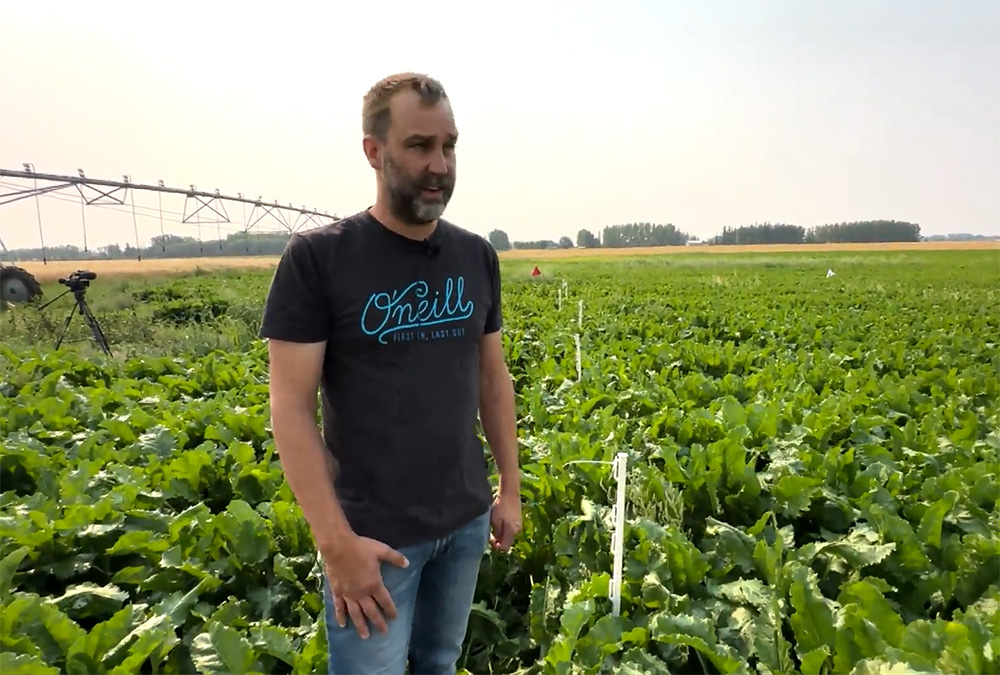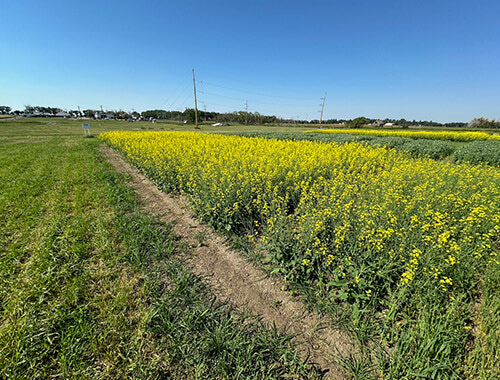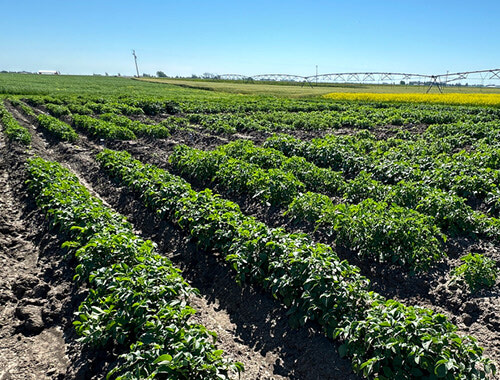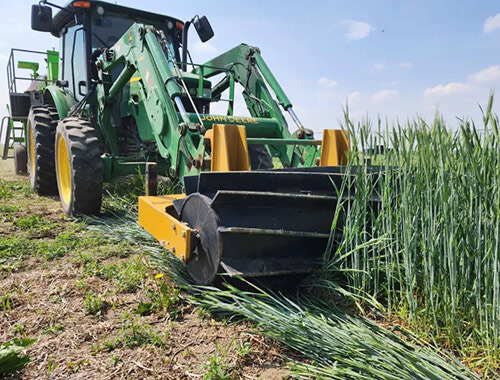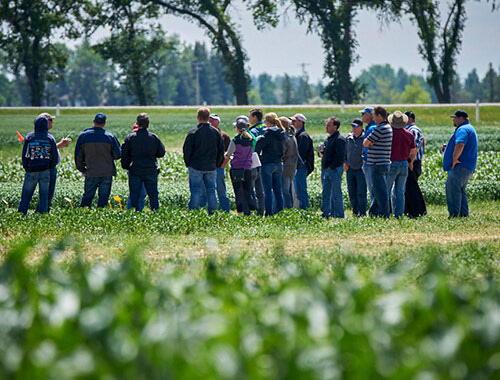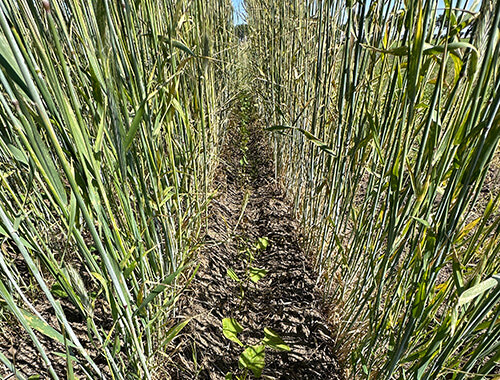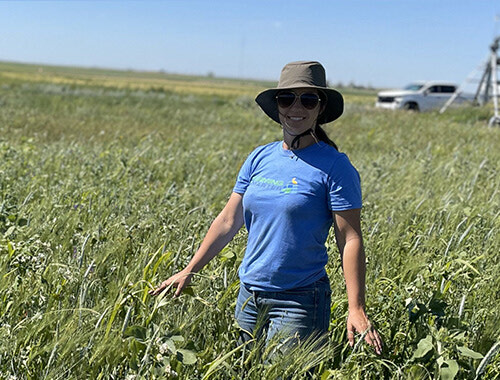Southern Alberta farmers and agronomists stand to gain more relevant, regional soil conservation knowledge for numerous crops from Farming Smarter’s research. A funding extension ensures the completion of the on-going projects and opens the door for new projects to begin.
The Saving Soils umbrella of projects at Farming Smarter is co-funded by the Weston Family Foundation and RBC’s Tech for Nature grant. Each project explores the effectiveness of soil conservation practices aiming to enhance biomass production, soil health, and carbon sequestration.
The first projects, which kicked off in 2022, investigate cover crop termination methods to maintain soil structure and improve carbon sequestration for the optimal growth of cash crops. These methods included roller crimping and the development of living mulch. Projects to explore fall cover crop options for post-sugar beet and -potato harvest also began at this time.
After the first year of the program, a project investigating optimal seeding rates and dates to maximize yield and minimize risk of winter/spring frost in camelina was added to the umbrella.
Growing the Conversation Around Conservation
Farming Smarter has received a funding extension from RBC’s Tech for Nature grant to include two additional years of field work. This aligns the expiration date of the grant with the Weston Family Foundation research grant.
Lewis Baarda, Field Tested Manager at Farming Smarter, hopes to use this extension as an opportunity to extend the conversation of adoption with growers.
“Everybody has an interest in protecting the soil. Making sure it’s going to be there, and it will be productive in the future is important. But nobody’s exactly sure about the best way to do that,” he states.
He wants to bring farmers better knowledge of the tools they need, and how to deploy them, to protect this asset.
Baarda’s Saving Soils research focuses on the fall cover crop trials. His team works with farmers across southern Alberta to investigate the performance of this practice following the harvest of potatoes and sugar beets. Discussions with farmers throughout the region keeps his research relevant to their needs and challenges – tailoring the protocols to replicate those of farmers.
This work supports the decision-making process for on-farm operations and identifies the essential factors behind those choices.
“There’s an uncertainty towards how well new things will work in their field. Costs and logistics are major considerations before something is adopted on-farm. If we find the perfect solution, but it’s going to cost $100 an acre, nobody’s going to do it,” he comments.
However, the most challenging consideration Baarda’s research contends with is the weather.
|
|
|
Lewis Baarda shares an update on the sugar beet cover crop project in a Plot Shot video for Farming Smarter in 2024 |
Weather is the biggest limiting factor with planting cover crops. Recent years have seen dry springs, scorching summers, and wide-open falls. When the weather goes against conventional wisdom, it adds to the uncertainty.
"If I’m a farmer and it’s October 1st, I want to know what my options are. Do I have time to seed cover crops or am I too late? What do I plant, what are my rates? And most importantly, if I’m going invest this time and money into cover crops, is it going to work and make a difference?” Baarda presents.
Baarda uses winter wheat as an example; a common cover crop grown in southern Alberta. Conventional wisdom states you must seed it by September 15, otherwise it won’t grow enough to survive the winter and be a viable crop the next year.
This change from typical weather patterns has seen the area go without a killing frost until November. Winter wheat will have a limited growth until it gets hit by that frost and experiences a vernalization period. With a long, open fall it will have more time to grow before undergoing that process and producing a much better crop come spring.
When weather is uncharacteristic for regional norms, farmers require more information to make effective decisions. These decisions can be supported by research completed throughout these uncharacteristic events.
“It becomes part of the context for the story,” Baarda says. “We can say this is what it looks like in a dry year, and this is what it looks like in a wet year. That’s the advantage of being able to adapt in on-going research.”
Farmers do everything they can to accommodate their fields during these periods, but don’t always know the best ways to go about it due to an abundance of options. Maintaining discussions with farmers is critical to reducing these choices to the best few.
“Having discussions lets us learn from farmers; we learn what works for them, we test it in a controlled research environment, then learn what worked or didn’t work. The farmers take that information, try it out and learn something new from their work. They come back to us and say this worked, this didn’t,” he adds.
Through his process, Baarda’s research develops an iterative approach, as he goes back and forth with the farmers to narrow in on what works best.
Or, in Baarda’s words, it becomes a community effort.
Farming Smarter invites you to join the conversation and follow the journey studying these opportunities for growers and agronomists across the Prairies! For more information on a specific project, check out the individual project pages below. Or watch the project playlist to see how the trials evolve!
|
Catch up on all the work from the many Saving Soils projects all in one place! |
Check out the project pages!
2023-2026
Farmers in southern Alberta have a vested interest to protect their soils from wind erosion overwinter and trap soil moisture to combat summer droughts. However, they require options that won't interrupt their cash crop rotations. Fall-seeded camelina stands to provide an answer to both of these concerns with overwinter protection while being a cash crop.
2022-2027
As part of the Saving Soils initiative, Farming Smarter explores nurse crop, cover crop, and relay crop practices in irrigated potato trials to reduce soil erosion and improve soil quality in potato production.
2022-2026
In response to growing interest of cover crops, we have begun a 4-year project investigating the viability, management, and benefits of their adoption. While it is known that cover crops have many benefits for erosion control and weed suppression, we want to explore the lengths of their benefits for your soil.
2022-2026
Annual crop systems can be optimized with the addition of cover crops. By terminating the cover crops at the right time, you can provide your cash crop with an extra source of organic matter, wind cover, with an edge in weed competition.

